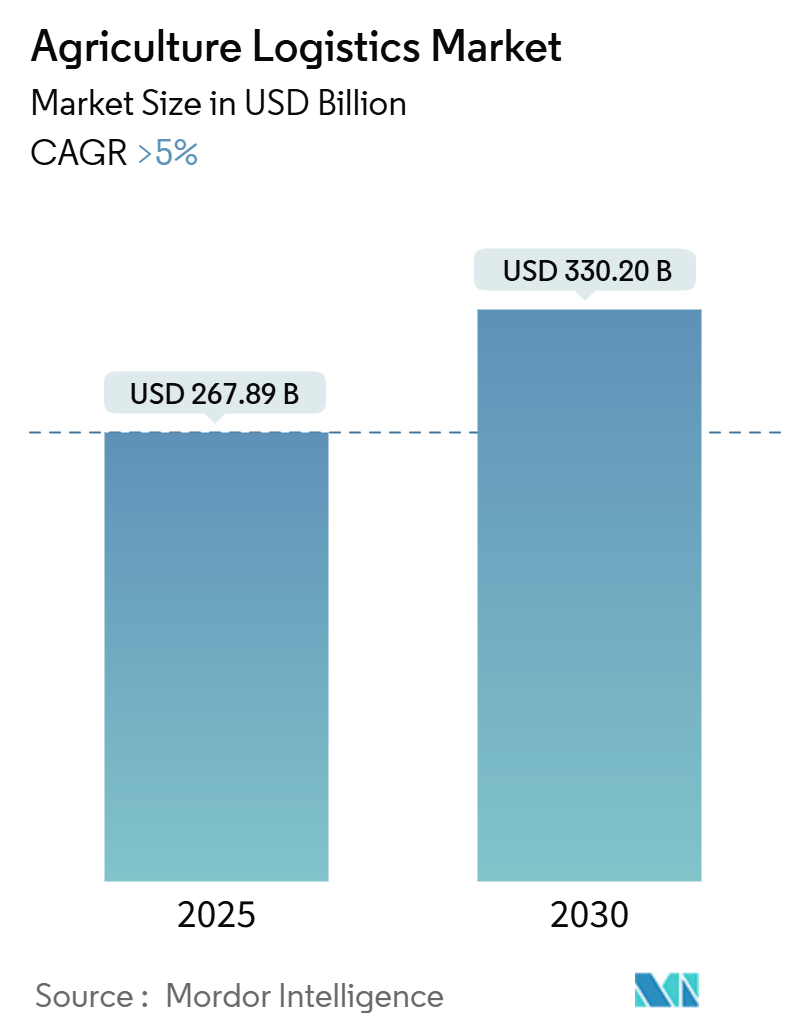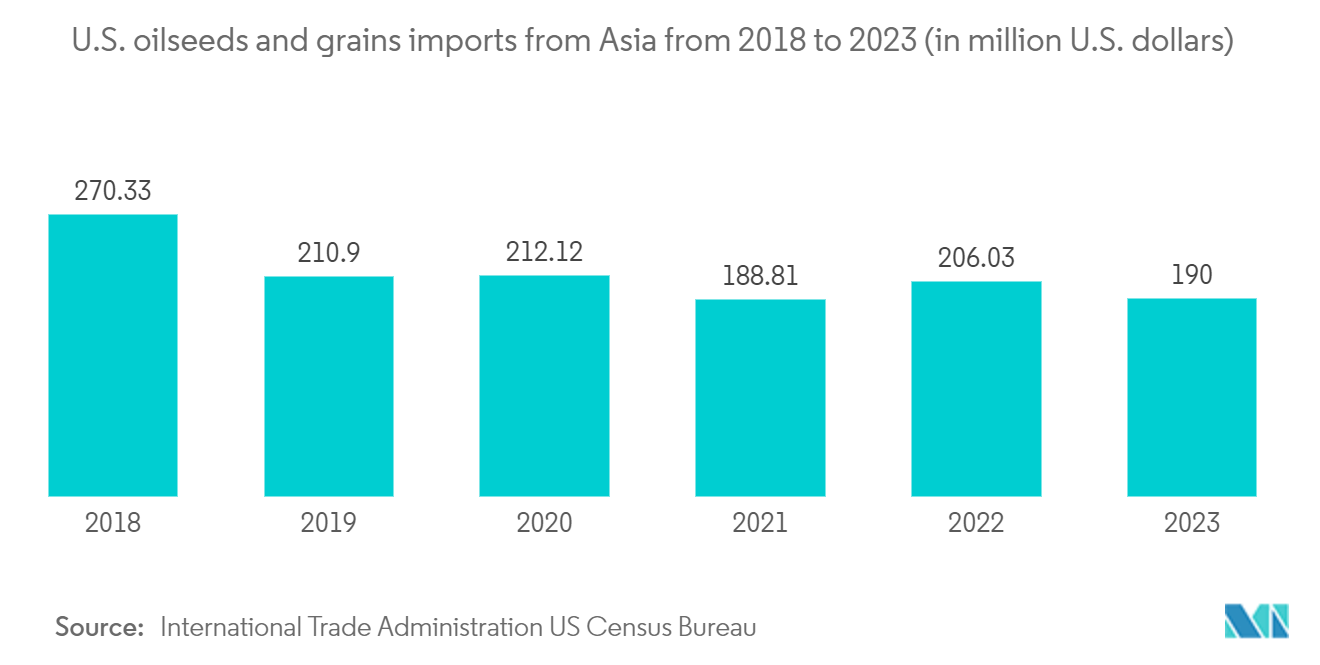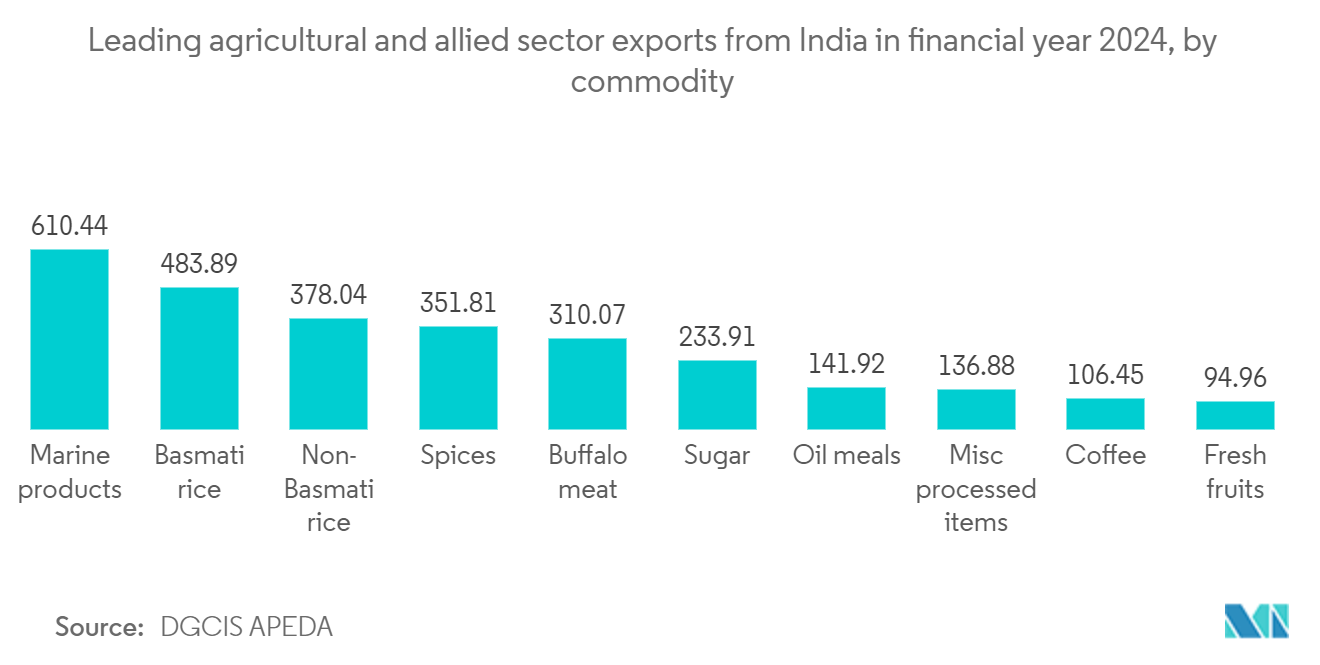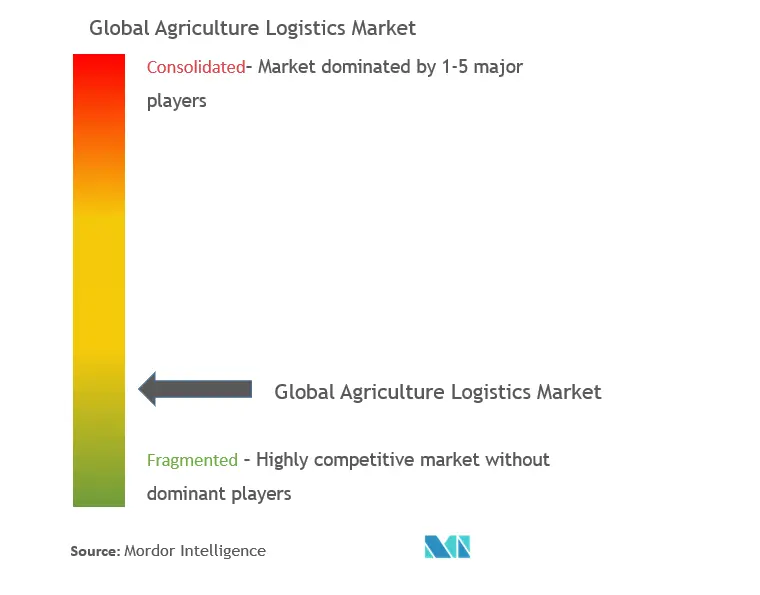Agriculture Logistics Market Size and Share

Agriculture Logistics Market Analysis by Mordor Intelligence
The Agriculture Logistics Market size is estimated at USD 267.89 billion in 2025, and is expected to reach USD 330.20 billion by 2030, at a CAGR of greater than 5% during the forecast period (2025-2030).
As the global population grows and dietary preferences evolve, the demand for food products is surging, placing immense pressure on agricultural logistics to ensure timely deliveries. With a notable shift of populations from rural to urban settings, cities are witnessing a heightened demand for agricultural products.
This urban concentration necessitates more streamlined logistics to ferry food from rural producers to urban consumers. Furthermore, urbanization is encroaching on agricultural land near cities, not just through direct land conversion but also via non-productive rural activities like recreation. Such encroachments push agricultural production further from urban hubs, potentially elongating supply chains.
Urban retailers, particularly in the fast-moving consumer goods (FMCG) sector, are increasingly seeking more frequent deliveries of smaller quantities. This strategy aims to minimize storage space and enhance product freshness, but it also complicates last-mile logistics. In the wake of Russia's invasion of Ukraine, countries worldwide have ramped up trade-related policies. These measures, often aimed at bolstering domestic supply and curbing prices, have exacerbated the global food crisis.
By June 2024, 16 nations had enacted 22 food export bans, while 8 countries implemented 15 export-limiting measures. As urban areas grapple with rising congestion and strained infrastructure, the challenge of efficiently distributing agricultural products intensifies, underscoring the demand for innovative urban logistics solutions.
In April 2024, online grocery sales surged to USD 8.5 billion, marking a 4.4% increase from the previous year's USD 8.2 billion. Of this, U.S. online grocery shoppers allocated USD 3.7 billion to pickups, a 2.1% rise from April 2023's USD 3.6 billion. Meanwhile, delivery sales reached USD 3.3 billion, reflecting a 4.3% growth from the prior year's USD 3.1 billion. Notably, monthly active users saw an uptick across all surveyed age demographics.
Temperature fluctuations pose a significant risk to the quality of perishable goods, impacting their appearance, taste, texture, and nutritional value. For instance, fruits and vegetables can wilt, discolor, or even mold when subjected to suboptimal temperature variations. Likewise, dairy products, meats, and seafood are highly vulnerable to spoilage and bacterial growth if not maintained at their ideal temperatures.
In conclusion, the evolving dynamics of population growth, urbanization, and changing dietary preferences are reshaping the agricultural logistics landscape. The increasing complexity of supply chains, coupled with trade-related policies and urban infrastructure challenges, necessitates innovative solutions to ensure efficient food distribution.
The rise in online grocery sales highlights the growing consumer reliance on digital platforms, further emphasizing the need for robust logistics systems. Addressing temperature control in the supply chain remains critical to maintaining the quality of perishable goods. As these trends continue to evolve, stakeholders must adapt to ensure the sustainability and efficiency of agricultural logistics.
Global Agriculture Logistics Market Trends and Insights
Transportation services are taking the lead in market dominance.
Transport costs significantly influence food prices and food security, especially in the world's poorest nations, where food can consume up to 70% of household budgets. In certain African regions, local transport costs can account for as much as 50% of food prices. Many developing nations grapple with high transportation costs and delays due to inadequate infrastructure and inefficient transport services.
These challenges result in food price volatility, shortages, and post-harvest losses. For instance, the World Resources Institute highlights that in sub-Saharan Africa, annual post-harvest losses for grains alone surpass the decade's worth of food aid value and match the yearly cereal import value.
Russia's early 2022 invasion of Ukraine intensified food supply challenges already set in motion by the pandemic. The invasion temporarily stalled Ukraine's grain exports, prompting efforts to find alternative global market connections, especially for grains. The dual impacts of COVID-19 and the Ukraine conflict drove the Food and Agriculture Organization's Food Price Index up by 56% in real terms from February 2020 to its March 2022 peak. While the index has since declined, it remained 10% higher in real terms in February 2024 compared to February 2020.
In December 2023, the Asian Development Bank (ADB) greenlit two projects worth a combined USD 157.1 million, aimed at boosting agricultural competitiveness and refining trade and logistics in Mongolia. The USD 57.1 million Phase 2 Agriculture and Rural Development Project seeks to bolster Mongolia's agricultural sector, making it more competitive and climate-resilient. The initiative will back agriculture-related enterprises in adopting technologies to boost processing and value-added manufacturing. Additionally, it aims to elevate agro-enterprise operations and quality standards, thereby enhancing exports.
Beyond that, the project intends to assist herders and farmers in optimizing production. This includes elevating livestock and agricultural product quality, fostering climate-resilient production, refining animal husbandry practices, and offering essential equipment training. A key focus is also on weaving herders and farmers into value chains to boost their earnings.
With backing from the World Bank, nations are expanding their transportation infrastructure, crafting resilient networks both in rural and regional areas. These transport operations, tailored to specific needs, typically merge infrastructure elements like ports, roads, railways, airports, and border crossings with necessary policy and regulatory reforms.
The overarching goal is to grant farmers improved access to agricultural inputs and ensure people enjoy heightened food security with better access to fresh, diverse, and affordable food. Moreover, by reducing transport costs, there's a notable decrease in food waste, further bolstering economic development.
In conclusion, addressing transportation costs and infrastructure inefficiencies is crucial for enhancing food security and economic stability in developing regions. Investments in infrastructure and technology, as seen in Mongolia and supported by global institutions like the World Bank and ADB, are pivotal. These efforts not only improve food supply chains but also foster economic growth and resilience against future disruptions.

The agriculture logistics market is being dominated by the Asia-Pacific region.
As the global population continues to rise, agriculture has adapted, becoming more efficient and managing to meet the increasing demand with only a modest rise in land use. Projections indicate that to satisfy the world's food needs by 2050, an additional 600 million hectares of land will be required, driven by population growth and evolving lifestyles.
While Southeast Asia has the capacity to partially address this demand, challenges like soil degradation, deforestation, and urbanization threaten the agricultural viability of significant land areas. Southeast Asia plays a pivotal role in the global food supply, contributing over 90% of the world's rice production and witnessing increases in the output of various crops, meat, poultry, and fish.
This reliance on the region's agricultural prowess is expected to spur investments in upstream agri-technology, services, and sciences. With agricultural production valued at USD 400 billion, accounting for 12% of the region's GDP, projections indicate a 25% increase by 2031, with crop production making up 62% of the total output. Malaysia and Indonesia lead in palm oil production, with Malaysia also exporting rubber, cocoa, and wood products, and Indonesia focusing on coffee, vegetables, and fruits.
Vietnam and Thailand excel in rice, seafood, and fruit production, with Thailand also processing tuna and sugar, and Vietnam offering coffee, tea, and cashew nuts. Other nations in the region also contribute to the agricultural market. India, with a population nearing 1.42 billion, stands as a major agricultural exporter, utilizing over 51% of its land for cultivation.
The Indian government is actively promoting initiatives to enhance warehousing opportunities. One such initiative is the "Central Sector Scheme – Pradhan Mantri Krishi SAMPADA," aimed at establishing mega food parks, integrated cold chains, and agro-processing clusters. The government is also expanding rice storage facilities, with India's inaugural rice silos set to launch in Bihar, boasting a capacity of 0.25 million tonnes, constructed by NCML.
In May 2023, an inter-ministerial committee was established to oversee an ambitious grain storage initiative in the cooperative sector, targeting a 70 million tonne increase in storage capacity, with a budget of Rs 1,000 billion. By October 2023, operational silos managed by FCI and state agencies reached a storage capacity of 1.97 million tonnes, with 70% developed through public-private partnerships involving firms like Adani Agri Logistics and NCML.
FCI plans to expand its capacity to 11.11 million tonnes across 249 locations in 12 states by 2026, with an investment of Rs 92.36 billion. As of August 2023, projects totaling 4.44 million tonnes are underway in 10 states, expected to finish by 2024-25, with Uttar Pradesh leading in capacity development, trailed by Punjab and Bihar.
Dominating the agriculture logistics market, the Asia-Pacific region, especially China and India, is witnessing rapid food demand growth, bolstered by substantial investments in cold chain logistics and infrastructure, and the involvement of major logistics players, all underpinned by robust government support and the region's key role in global agricultural trade.
In conclusion, the agricultural sector in Southeast Asia and India is poised for significant growth and transformation. The increasing global demand for food, coupled with strategic investments and government initiatives, will drive advancements in agricultural production and logistics.
Addressing challenges such as soil degradation and urbanization will be crucial for sustaining this growth. The region's ability to adapt and innovate will determine its success in meeting future food demands and maintaining its pivotal role in the global agricultural market.

Competitive Landscape
The Global Agriculture logistics market features a blend of both global and regional players, highlighting its fragmented nature. Driven by factors like e-commerce, technological integration, and the rise of burgeoning economies, the market is poised for growth during the forecast period.
Leading companies in the sector have embraced modern technologies, including warehousing management systems, automation, drone delivery, and advanced transportation management systems. These innovations have enhanced planning and tracking capabilities, leading to heightened productivity and a stronger value proposition. Notable players in this arena include DHL, Kuehne+Nagel AG, FedEx, CEVA Logistics, and United Parcel Service, among others.
In conclusion, the integration of advanced technologies and the expansion of e-commerce are set to drive significant growth in the Global Agriculture logistics market. Companies that continue to innovate and adapt to these trends will likely maintain a competitive edge, ensuring sustained development and efficiency in the sector.
Agriculture Logistics Industry Leaders
DHL
CEVA Logistics
Kuehne+Nagel International AG
Bollore Logistics
Fedex
- *Disclaimer: Major Players sorted in no particular order

Recent Industry Developments
- October 2024: A key innovation, the Smart Agri-Rail System, integrates agriculture with rail transport to boost efficiency, sustainability, and scalability in the global food supply chain. Experts predict the market for this system will exceed USD 7.5 billion by 2032, highlighting its growing significance and potential to transform modern agriculture.
- August 2024: Constellation Cold Logistics ("Constellation" or the "Company") has announced its agreement to acquire Agri-Norcold A/S ("Agri-Norcold"). This marks Constellation's inaugural venture into the Danish market, bolstering its European presence and enhancing service offerings in the Nordics for both existing and prospective clients. Agri-Norcold operates 10 strategically located facilities, positioned near key food production hubs, import/export points, and major cities, ensuring seamless transportation and logistics. With a vast network across Denmark, Agri-Norcold boasts 865,756 m3 of frozen storage (equivalent to 266,000 pallet spaces) alongside significant freezing and packing infrastructure.
Global Agriculture Logistics Market Report Scope
Agrologistics is a relatively new interdisciplinary field in the agricultural sector, including the. management of supply chains of agricultural products and raw materials from production to delivery to the consumer, combining agricultural production, marketing, management, and logistics.
A complete background analysis of the Agriculture Logistics market, which includes an assessment of the economy, market overview, market size estimation for key segments, emerging trends in the market, market dynamics, and key company profiles, are covered in the report. The impact of COVID-19 has also been incorporated and considered during the study.
Global agriculture logistics market is segmented by service (transportation, warehousing, and value-added services), by end-user (small and medium enterprises (smes), and large enterprises), by geography (North America, Europe, Asia-Pacific and LEMEA). The report offers market size and forecast values (USD billion) for all the above segments.
| Transportation |
| Warehousing |
| Value-added Services |
| Small and Medium Enterprises (SMEs) |
| Large Enterprises |
| North America | United States |
| Canada | |
| Mexico | |
| Europe | Germany |
| France | |
| United Kingdom | |
| Rest of Europe | |
| Asia-Pacific | China |
| Japan | |
| South Korea | |
| India | |
| Rest of Asia-Pacific | |
| LAMEA | Brazil |
| South Africa | |
| GCC | |
| Rest of Latin America and Middle East and Africs |
| By Service | Transportation | |
| Warehousing | ||
| Value-added Services | ||
| By End-User | Small and Medium Enterprises (SMEs) | |
| Large Enterprises | ||
| By Geography | North America | United States |
| Canada | ||
| Mexico | ||
| Europe | Germany | |
| France | ||
| United Kingdom | ||
| Rest of Europe | ||
| Asia-Pacific | China | |
| Japan | ||
| South Korea | ||
| India | ||
| Rest of Asia-Pacific | ||
| LAMEA | Brazil | |
| South Africa | ||
| GCC | ||
| Rest of Latin America and Middle East and Africs | ||
Key Questions Answered in the Report
How big is the Agriculture Logistics Market?
The Agriculture Logistics Market size is expected to reach USD 267.89 billion in 2025 and grow at a CAGR of greater than 5% to reach USD 330.20 billion by 2030.
What is the current Agriculture Logistics Market size?
In 2025, the Agriculture Logistics Market size is expected to reach USD 267.89 billion.
Who are the key players in Agriculture Logistics Market?
DHL, CEVA Logistics, Kuehne+Nagel International AG, Bollore Logistics and Fedex are the major companies operating in the Agriculture Logistics Market.
Which is the fastest growing region in Agriculture Logistics Market?
Asia-Pacific is estimated to grow at the highest CAGR over the forecast period (2025-2030).
Which region has the biggest share in Agriculture Logistics Market?
In 2025, the Asia-Pacific accounts for the largest market share in Agriculture Logistics Market.
What years does this Agriculture Logistics Market cover, and what was the market size in 2024?
In 2024, the Agriculture Logistics Market size was estimated at USD 254.50 billion. The report covers the Agriculture Logistics Market historical market size for years: 2019, 2020, 2021, 2022, 2023 and 2024. The report also forecasts the Agriculture Logistics Market size for years: 2025, 2026, 2027, 2028, 2029 and 2030.
Page last updated on:
Agriculture Logistics Market Report
Statistics for the 2025 Agriculture Logistics market share, size and revenue growth rate, created by Mordor Intelligence™ Industry Reports. Agriculture Logistics analysis includes a market forecast outlook for 2025 to 2030 and historical overview. Get a sample of this industry analysis as a free report PDF download.



